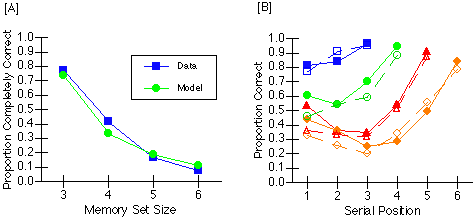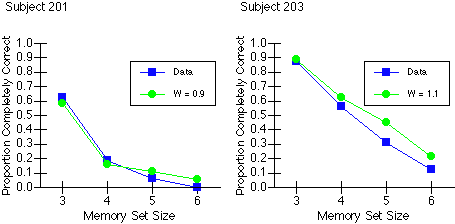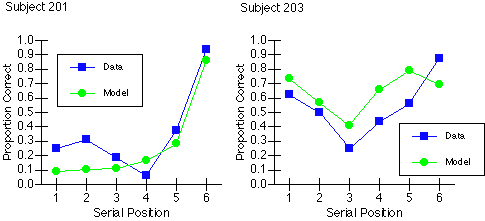
Figure 1. Data and model predictions from a representative experiment.
This work was supported by Air Force Office of Scientific Research Grant F49620-97-1-0455 and in part by Office of Naval Research Grant N00014-95-1-0233
Working memory resources are drawn upon in the performance of any cognitive task. Typically, these resources are assumed to be limited and performance is degraded on tasks that require resources in excess of those limits. Our model conceptualizes working memory resources as a type of attentional activation, called source activation. Source activation spreads from the current focus of attention to the memory nodes relevant to the current task and maintains those nodes in an accessible state.
To test this model of working memory, we construct ACT-R models of working memory tasks and compare the predictions of the model to the performance of subjects. A unique feature of this project is that we compare the model, not only to performance aggregated over subjects, but also to the performance of individual subjects. Further, we obtain the individual subject fits by varying only ACT-R's source activation parameter, W.
The tasks we use is a modified digit span (MODS) task. In this task, subjects read aloud strings of letters and digits and are later prompted to recall the digits. Memory load is manipulated by varying the number of digits to be recalled on each trial. The data (aggregated over subjects) and corresponding model fits from one of our experiments are shown in Figure 1. Panel A shows proportion of strings correctly recalled as a function of memory set size and panel B the proportion of recall as a function of serial position.

Figure 1. Data and model predictions from a representative experiment.
Our model, though, is capable of more detailed predictions. Figure 2 shows the model's fit to the data of two individual subjects. The model also successfully predicted subjects' serial position curves as shown in Figure 3. It should be emphasized that these individual subject fits were obtained using only a single parameter per subject.

Figure 2. Model predictions for individual subject data.

Figure 3. Model predictions for individual serial position curves.
To date we have successfully modeled subjects in 3 variations of a modified digit span task. In one, we modeled the speedup in performance when the same subjects participated in multiple sessions. We have also shown that our estimates of source activation for individual subjects correlates strongly with performance on a matrix completion task that also depends heavily on working memory resources. Currently, we are modeling a second task, with the hopes that estimates of working memory capacity (measured by ACT-R's source activation parameter W) obtained from the two tasks will be highly similar.
Copyright © 1998 Larry Z. Daily